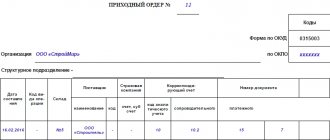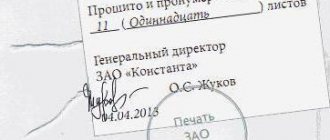In the program “1C: Public Institution Accounting 8”, ed. 2.0 supports the maintenance of records of separate divisions, both allocated to an independent balance sheet and not allocated. This material from 1C experts describes how to set up and keep records of the operations of a separate division that is not allocated to a separate balance sheet.
The concept of “separate division” is regulated by the Civil and Tax Codes of the Russian Federation. According to Art. 55 of the Civil Code of the Russian Federation, a separate division of a legal entity is located outside the location of the legal entity. A separate division is not a legal entity. It is endowed with the property of the legal entity that created it, and acts on the basis of the provisions approved by it.
According to Article 11 of the Tax Code of the Russian Federation, a separate division of an organization is any territorially separate division from it, at the location of which stationary workplaces are equipped. Recognition of a separate division of an organization as such is carried out regardless of whether its creation is reflected or not reflected in the constituent or other organizational and administrative documents of the organization, and on the powers vested in the specified division.
The current legislation does not contain requirements and criteria for the allocation of a separate division “on a separate balance sheet”. The decision to allocate a division to a separate balance sheet is made by the organization based on its own needs. A separate division on a separate balance sheet means a separate division that exercises the authority to maintain accounting records and prepare financial statements.
According to Art. 13 of the Federal Law of December 6, 2011 No. 402-FZ “On Accounting”, accounting (financial) statements must include performance indicators of all divisions of an economic entity, including its branches and representative offices, regardless of their location. At the same time, Order of the Ministry of Finance of Russia dated March 25, 2011 No. 33n “On approval of the Instructions on the procedure for compiling and submitting annual and quarterly financial statements of state (municipal) budgetary and autonomous institutions” provides for the formation of financial reporting forms by separate divisions carrying out accounting.
The program “1C: Public Institution Accounting 8”, edition 2 supports accounting for separate divisions of two types:
- a separate division allocated to an independent balance sheet;
- a separate division that is not allocated to an independent balance sheet.
Accounting for separate divisions allocated to an independent balance sheet can be maintained either in a separate database or in a single database with the head office. In the latter case, in the Organization
information is entered both about the head office and about separate divisions allocated to an independent balance sheet. The general ledger, balance sheet and other accounting registers and regulated reports can be generated consolidated for a group of institutions or separately for institutions and separate divisions allocated to an independent balance sheet.
Accounting for separate divisions that are not allocated to an independent balance sheet is maintained in a single database with the parent institution. Information about separate divisions that are not allocated to an independent balance sheet is entered into the Divisions directory.
Divisions that are separate are assigned the
Separate division
, by which the program will distinguish them from regular divisions of the organization.
For separate divisions you can specify:
- The name for the primary documents, which will be displayed in the primary documents;
- Information about the registration of the organization with the tax authority at the location of the separate division;
- A sign of maintaining separate numbering of documents. Documents with the specified separate division will be assigned a number taking into account the prefix. In this case, the department prefix replaces the organization prefix;
- Responsible persons of the department. When preparing documents, the responsible persons signing the document will be determined taking into account the separate division indicated in the document;
- Address and telephone numbers of a separate unit;
In the program “1C: Public Institution Accounting 8”, ed. 2.0 for a separate division not vested with the right to conduct accounting (not allocated to an independent balance sheet), the following is provided:
- possibility of dedicated document flow;
- indication in the documents of the details of a separate division;
- maintaining a separate cash register;
- maintaining separate plans for financial and economic activities;
- registration of payment documents for personal accounts of departments in the treasury or bank.
Also in the program “1C: Public Institution Accounting 8”, ed. 2.0 provides the ability to set up analytical accounting by division for selected accounts in the chart of accounts.
Cash management in a separate department
According to the Directive of the Bank of Russia dated March 11, 2014 No. 3210-U, separate divisions that have a cash register must maintain a cash book and transfer to the legal entity a copy of the cash book sheet in the manner established by the legal entity, taking into account the deadline for the legal entity to prepare accounting (financial) statements.
For each separate division, a separate section of the cash book is maintained with the name (number) of the division indicated on its title page. This section of the cash book is transferred to the head office, where a single cash book is formed.
Primary accounting documents (expenditure and cash receipt orders) are independently generated by the cashier of a separate structural unit (branch). Their numbering is carried out in the order established in the Accounting Policy of the organization.
The cashier's report is drawn up in two copies. The first remains in a separate unit, the second, together with the documents attached to it, is transferred to the head office.
In “1C: Public Institution Accounting 8”, ed. 2 provides for maintaining a separate cash book f. 0504514 and cash register register f. 0310003 for divisions with an established sign of separate numbering of documents, as well as for the parent organization (without separate divisions).
Cash documents of divisions that do not have a separate numbering of documents (keeping a cash book), or that are not separate, are registered in the cash book and the register of cash orders of the parent organization.
Cash documents of a separate division have a separate numbering, the responsible persons of the division are indicated as responsible persons, and the name of the separate division is displayed in printed forms (see Fig. 1).
It should be noted that in primary documents and cash reports that provide the Structural unit
, the name of the separate division is displayed in this field; if the form does not contain such details, the name of the separate division is added to the name of the organization.
Rice. 1
Cashier's report
and
Cash Book
can be generated both for a separate division and for the entire organization as a whole, without taking into account separate divisions.
It also provides for the formation of a Cash Book
for all separate divisions and the organization as a whole.
In this case, Cash Books
will be displayed on separate tabs (see Fig. 2).
Rice. 2
List of objects
The next step is to understand the meaning of each of the independent objects - “separate division”, “branch”, “representative office”.
At first glance, we are talking about territorial isolation, which is characterized by an address different from the state registration address of the company.
Accountants tend to view a separate division in the special meaning given to this term by tax law. The main feature of such a separate unit is the period for which workplaces are equipped in it. And if a workplace exists for less than a month, then it does not generate a separate division. However, we should not forget about the limited application of this criterion. Such a sign of a separate division as a term “works” only in acts of legislation on taxes and fees. This is directly stated in paragraph 1 of paragraph 2 of Article 11 of the Tax Code. The regulation adopted by the Bank of Russia does not apply to such acts (Clause 1, Article 4 of the Tax Code of the Russian Federation). It is intended to organize cash circulation (Article 34 of the Law of July 10, 2002 No. 86-FZ “On the Central Bank of the Russian Federation (Bank of Russia)”).
Let us explain this with a specific example. Let's assume that a company has opened a retail outlet without defining a period and it has been operating for less than a month. From the point of view of tax legislation, it does not have a separate division. But this does not mean that there is none for the purpose of maintaining cash discipline. This position is supported by the letter of the Ministry of Finance of Russia dated October 8, 2012 No. 03-02-07/1-242. It emphasizes that an organization that has a separate “tax” division is subject to registration with the tax authority at the location of such division. But the fact of such accounting cannot influence the procedure for conducting cash transactions.
Plans for receipts and disposals (FCD plans)
According to Order of the Ministry of Finance of Russia dated July 28, 2010 No. 81n “On the requirements for the plan of financial and economic activities of a state (municipal) institution”, a state (municipal) budgetary and autonomous institution, their separate (structural) divisions without the rights of a legal entity, exercising powers to maintain accounting accounting, draw up, in accordance with these Requirements, a Plan of financial and economic activities of a state (municipal) institution (hereinafter referred to as the FCD Plan) in the manner determined by the executive body (local government body) exercising the functions and powers of the founder in relation to the institution, unless otherwise established federal laws, regulatory legal acts of the President of the Russian Federation or the Government of the Russian Federation.
In "1C: Public Institution Accounting 8", ed. 2.0 for separate divisions that do not maintain accounting records (not allocated to an independent balance sheet), the opportunity to maintain a financial accounting plan is also provided. To do this, in the document for registering planned (forecast) indicators of receipts and disposals, it is possible to indicate a separate division that is not allocated to an independent balance sheet (Fig. 3).
Rice. 3
How to maintain cash books if you have an OP
Not so long ago, companies had to maintain only one cash book for the entire organization. But from January 1, 2012, each separate division (SU) that works with cash has its own cash book. With the help of a specialist from the Cash Circulation Department of the Bank of Russia, we decided to sort out some of the questions that accountants have when maintaining the cash book of an individual enterprise.
Content
How to transfer sheets of a “separate” cash book to an organization
The OP must maintain a cash book, even if it:
- does not have a bank account;
- not allocated to a separate balance sheet;
- does not have the status of a branch or representative office;
- not registered with the tax authority.
And you need to focus on one single sign: where there is cash movement, there must be a cash book. It can be carried out:
in paper form;
using the program, making a printout at the end of the working day.
After the cash book sheet for the day is filled out, the second copy of it must be somehow transferred by the OP to the head office of the organization (GP) no later than the next working day. We were told how to do this in the Cash Circulation Department of the Bank of Russia.
FROM AUTHENTIC SOURCES
According to the explanations of the Cash Circulation Department of the Bank of Russia
“Regulation of the Bank of Russia dated October 12, 2011 N 373-P “On the procedure for conducting cash transactions with banknotes and coins of the Bank of Russia on the territory of the Russian Federation” provides for the maintenance of cash books by a legal entity and separate divisions of this legal entity on paper, by hand or with the use of technical means intended for processing information, including a personal computer and software, with printing of a sheet of the cash book on paper. In the case of registering a cash book on paper by hand, a separate department shall hand over a tear-off copy of the cash book sheet, and in the case of registering a cash book using technical means, a second copy of the cash book sheet printed on paper. The transfer by a separate division to a legal entity of a copy of the cash book sheet can be carried out in any available way determined by the legal entity (for example, by courier, by mail, fax, e-mail).
When a separate division transfers a cash book sheet to a legal entity in electronic form, it is also necessary to ensure the transfer of a copy of the cash book sheet on paper in accordance with the document flow rules approved by the legal entity.”
That is, immediately after compiling a sheet of the cash book, it is necessary to transfer to the State Enterprise not the sheet itself on paper, but the information from it. You can submit a paper copy of the sheet later. But this must be done at least once a year.
FROM AUTHENTIC SOURCES
Bank of Russia
“Second copies of the cash book sheet for each separate division are selected in chronological order and bookleted as necessary by the legal entity, but at least once a year.”
There were no “cash” transactions: what to transfer to the State Enterprise
Some accountants believe that if there are no cash transactions during the working day, it is still necessary to draw up a sheet of the cash book for that day. To do this, on the sheet for that day, follow the line “Balance at the end of the day” in column 4 “Receipt, rub. cop." data on the balance available at the beginning of the day is transferred, and dashes are placed in the remaining lines. In this case, the OP transfers “blank” sheets to the organization. But Central Bank specialists explained that in such a situation there is no need to fill out a sheet of the cash book. It turns out that there is simply nothing to transfer to the head office.
FROM AUTHENTIC SOURCES
Bank of Russia
“Since the cash book is maintained on the basis of incoming cash orders and outgoing cash orders issued for received and issued cash, the cash book sheet is not filled out if no cash transactions were carried out with cash during the working day.”
We reflect the “cash” transactions of the OP
The accountant of the parent organization, based on the received sheets of the cash book, will make entries in the accounting (unless, of course, the OP is allocated to a separate balance sheet). But is it necessary to reflect the receipt of money or the expenditure of money from the OP’s cash register in the GP’s cash book?
Unfortunately, there are already court decisions in which the courts came to the conclusion that the proceeds should be accounted for in the cash book not only of the OP, but also of the “head”. As a result, it was recognized as legitimate to hold organizations accountable under Part 1 of Art. 15.1 of the Code of Administrative Offenses of the Russian Federation for failure to post cash to the cash register.
However, in this situation, no money actually came to the GP cash desk from the OP. And entries in the cash book appear for a reason, but on the basis of receipt and expenditure orders. No real movement of money - no order. But there is no order, which means that no entries should appear in the cash book for the state enterprise. Besides:
- a cash register is a place that is determined by the manager for performing cash transactions, and a cash book is maintained to record the movement of cash in a specific cash register, and not throughout the organization as a whole;
- filling out a cash book on the basis of a cash sheet of another cash book is not provided for by Regulation No. 373-P.
This was confirmed to us by the Central Bank.
FROM AUTHENTIC SOURCES
Bank of Russia
“Data on transactions performed in a separate division are not included in the cash book of a legal entity.”
CONCLUSION
For those organizations that have decided that it is advisable for them to maintain only a cash book for the organization, and not to open cash books in the OP, it is important to understand the following. If tax officials come to them with an audit and do not see the cash book for the OP, then a fine for not posting revenue cannot be avoided. The tax authorities’ argument is simple: no OP cash book means no capitalization. And the courts will most likely support them.
***
What is the purpose of transferring to the GP information about the balance of cash stored in the OP?
Of course, this is control over compliance with the cash storage limit for the organization as a whole, especially if a separate limit has not been established for the OP (due to the lack of a current account).
First published in the journal "Glavnaya Ledger" 2013, N 22
Kulagina O.
Find out more about the journal "General Ledger"
Legal documents
- Art. 15.1 Code of Administrative Offenses of the Russian Federation
Personal accounts of separate divisions in the treasury or bank
If separate personal accounts are opened for separate divisions, such accounts are created and stored in the same directory Personal accounts
, where are the accounts of the parent organization.
The personal account card allows you to indicate:
- officials who have the right to sign payment and other documents when performing transactions on the personal account of a separate division;
- details of the department, TIN, KPP and name, which will be displayed in payment documents (see Fig. 4).
Rice. 4





